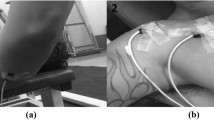Abstract
This study analyzes the performance of knee extension and flexion of Taekwondo and Kickboxing athletes. The power values were extracted through electromyography obtained by an isokinetic dynamometer at 60° per second. These values are resulted from the square of the electromyography signal. The analysis of kick power was made using a modified wavelet algorithm considering values with 95% significance. Both groups presented equivalent power and torque capacity with different training times and experience, on the other hand, the wavelet analysis showed better results in muscular recruitment performance in athletes with more experience, in other words, power is not only performance but also power plus recruitment produces better results. This study uniquely showed that muscular enhancement capacity is not only related to the power capacity of contraction but also to motor coordination.


Similar content being viewed by others
Notes
In this case, power is the value obtained from the square of the electromyography signal using the wavelet as a logic filter with 5% of significance considered for this calculus. It is similar to RMS with statistical criteria.
References
Aggeloussis N, Gourgoulis V, Sertsou M, Giannakou E, Mavromatis G (2007) Repeatability of electromyographic waveforms during the Naeryo Chagi in taekwondo. J Sports Sci Med 6:6–9
Baura H, Hirschmüllerb A, Müllera S, Gollhoferc A, Mayera F (2007) Muscular activity in treadmill and overground running. Isokinet Exerc Sci 15:165–171
Beis K, Tsaklis P, Pieter W, Abatzides G (2001) Taekwondo competition injuries in Greek young and adult athletes. Eur J Sports Traumatol Relat Res 23:130–136
Bouhlel E, Jouini A, Gmada N, Nefzi A, Ben AK, Tabka Z (2006) Heart rate and blood lactate responses during Taekwondo training and competition. Sci Sports 21:285–290
Crowther A, McGregor AH, Strutton PH (2007) Testing isometric fatigue in the trunk muscles. Isokinet Exerc Sci 15:91–97
Dauty M, Potiron-Josse M, Rochcongar P (2003) Consequences and prediction of hamstring muscle injury with concentric and eccentric isokinetic parameters in elite soccer players. Ann Réadapt Méd Phys 46:601–606
De Luca CJ (1997) Use of the surface electromyography in biomechanics. J Appl Biomech 13:135–163
Edward F, Delagi MD, John LMD (1981) Anatomic guide for the electromyographer the limbs, 2nd edn. Charles C Thomas, Springfield, IL
Enoka RM (2002) Neuromechanics of human movement. Human Kinetics, Champaign, IL
Fonseca JL, Magini M, Freitas TH (2009) Laboratorial gait analysis in patients with low back pain, before and after Pilates method intervention. J Sport Rehabil 18:269–282
Gartland MHAS, MELl Malik (2001) Injury and injury rates in Muay Thai kick boxing. Br J Sports Med 35:308–313
Green C, Petrou MJ, Fogarty-Hover ML, Rolf CG (2007) Injuries among judokas during competition. Scand J Med Sci Sports 17:205–210
Han DH, Kim JH, Lee YS, Bae S, Joeng BS, Kim HJ et al (2006) Influence of temperament and anxiety on athletic performance. J Sports Sci Med 5:381–389
Hewett TE, Myer GD, Zazulak BT (2008) Hamstrings to quadriceps peak torque ratios diverge between sexes with increasing isokinetic angular velocity. J Sci Med Sport 11:452–459
Kim JY (2006) Taekwon-do textbook, 2nd edn. Kukkiwon, Coréia
Lin WL, Yen KT, Doris Lu CY, Huang YH, Chang CK (2006) Anaerobic capacity of elite Taiwanese Taekwondo athletes. Sci Sports 21:291–293
Mohsen K, Judith W, Christopher M, Anthony RW (2006) A profile of Olympic taekwondo competitors. J Sports Sci Med 5:112–114
Neto OP, Magini M (2007) Electromiographic and kinematic characteristics of Kung Fu Yau-Man palm strike. J Electromyogr Kinesiol 18:1047–1052
Neto OP, Magini M, Pacheco MTT (2007) Electromyographic study of a sequence of Yau-Man Kung Fu palm strikes with and without impact. J Sport Sci Med 6:23–27
Neto OP, Magini M, Saba MM (2007) The role of effective mass and hand speed in the performance of kung fu athletes compared with non-practitioners. J Appl Biomech 23:139–148
Neto OP, Magini M, Saba MM, Pacheco MT (2008) Comparison of force, power, and striking efficiency for a Kung Fu strike performance by novices and experienced practitioners: preliminary analysis. Percept Mot Skills 106:188–196
Paiva JPLM, Kelencz CA, Paiva HM, Galvão RH, Magini M (2008) Adaptive wavelet EMG compression based on local optimization of filter banks. Physiol Meas 29:843–856
Philippou A, Bogdanis GC, Maridaki M (2007) Isotonic muscle function is selectively reduced after muscle damage induced by isometric exercise at a long muscle length. Isokinet Exerc Sci 15:69–75
Pieter W (2005) Martial arts injuries. Med Sci Sports 48:59–73
Pincivero DD (2001) Influence of contraction intensity, muscle, and gender on median frequency of the quadriceps femoris. J Appl Physiol 90:804–810
Probst MM, Fletcher R, Seelig DS (2007) A comparison of lower-body flexibility, strength, and knee stability between karate athletes and active controls. J Strength Cond Res 21:451–455
Rosene J, Fogarty TD, Mahaffey BL (2001) Isokinetic hamstrings: quadriceps ratios in intercollegiate athletes. J Athl Train 36:378–383
Saara MR, Markku K, Alexander M et al (2008) Surface EMG and acceleration signals in Parkinson’s disease: feature extraction and cluster analysis. Med Biol Eng Comput 46:849–858
Thompson WR, Vinueza C (1991) Physiological profiles of male and female Taekwondo black belts. Sports Med Train Rehabil 3:49–53
Torrence C, Compo GP (1998) A practical guide to wavelet analysis. Bull Am Meteorol Soc 79(1):61–78. Available from http://www.icess.ucsb.edu/gem/Torrence_and_Compo1998_wavelet_guide.pdf. Accessed on 20 September 2009
Acknowledgments
We also thank Prof. Haroldo Fraga de Campos Velho and Carlos Alberto Kelencz for helping obtain the data and all the volunteers.
Author information
Authors and Affiliations
Corresponding author
Rights and permissions
About this article
Cite this article
Machado, S.M., Osório, R.A.L., Silva, N.S. et al. Biomechanical analysis of the muscular power of martial arts athletes. Med Biol Eng Comput 48, 573–577 (2010). https://doi.org/10.1007/s11517-010-0608-z
Received:
Accepted:
Published:
Issue Date:
DOI: https://doi.org/10.1007/s11517-010-0608-z




